List of Italian foods and drinks
This article needs additional citations for verification. (May 2012) |
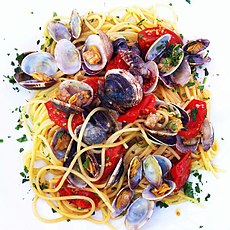 |
| Italian cuisine |
|---|
|
|



This is a list of Italian dishes and foods. Italian cuisine has developed through centuries of social and political changes, with roots as far back as the 4th century BC. Italian cuisine has its origins in Etruscan, ancient Greek, and ancient Roman cuisines. Significant changes occurred with the discovery of the New World and the introduction of potatoes, tomatoes, bell peppers and maize, now central to the cuisine but not introduced in quantity until the 18th century.[1][2] The cuisine of Italy is noted for its regional diversity,[3][4][5] abundance of difference in taste, and is known to be one of the most popular in the world,[6] with influences abroad.[7]
Pizza and spaghetti, both associated with the Neapolitan traditions of cookery, are especially popular abroad, but the varying geographical conditions of the twenty regions of Italy, together with the strength of local traditions, afford a wide range of dishes.
Dishes and foods
The cuisine of Italy has many unique dishes and foods.
Antipasto (appetizers)


- Breadsticks
- Bresaola
- Bruschetta – an antipasto from Italy consisting of grilled bread rubbed with garlic and topped with tomatoes, olive oil, salt and pepper
- Capicollo
- Crostini – means "little toast" in Italian
- Culatello
- Curried braised rabbit stew
- Insalata caprese
- Mozzarelline fritte – fried small mozzarellas
- Nervetti – pressed beef cartilage seasoned with onions
- Olives
- Peperoni imbottiti – stuffed peppers[8]
- Pizzette e salatini
- Prosciutto e melone – prosciutto and melon
- Salami
- Strolghino
- Tortano
- Verdure in pinzimonio
- Vezione verro
Zuppa e salsa (soups and sauces)
- Acquacotta – an Italian soup that was originally a peasant food. Historically, its primary ingredients were water, stale bread, onion, tomato and olive oil,[9] along with various vegetables and leftover foods that may have been available.[10][11]
- Agghiotta di lumache (Sicilian snail soup)
- Agliata
- Agrodolce
- Bagna càuda
- Garmugia
- Ginestrata
- Grine sauce
- Maccu
- Sugo al Pomodoro
- Minestra di ceci
- Minestra di pasta con pesce
- Minestrone
- Pasta e fagioli
- Ragù alla bolognese
- Ragù alla salsiccia
- Ragù – a meat-based sauce commonly served with pasta
- Risi e bisi
- Sciusceddu
- Stracciatella
- Boreto
- Fonduta (fondue)
- Minestra di fagioli
- Pesto
Pane (bread)


- Bari
- Bozza pratese
- Casatiello
- Ciabatta – an Italian white bread made from wheat flour, water, salt, olive oil, and yeast, created in 1982 by a baker in Adria, Veneto, Italy, in response to popularity of French baguettes
- Ciaccino
- Ciriola – typical bread of Rome
- Colomba Pasquale
- Coppia Ferrarese
- Crescentina
- Crocchè
- Farinata
- Ficattola
- Focaccia
- Fragguno
- Grissini torinesi
- Michetta – typical bread of Milan
- Moddizzosu
- Muffuletta
- Neccio
- Pandoro
- Pane carasau
- Pane casareccio
- Pane di Altamura
- Pane di Genzano (Lazio)
- Pane pugliese
- Pane rustico – traditional crusty peasant bread
- Pane toscano – without salt
- Panelle di ceci
- Panettone
- Panino
- Penia
- Piadina
- Pita – typical bread of Catanzaro
- Rosetta – typical bread of Rome
- Schiacciata
- Taralli
- Testarolo
- Tigella
- Tortano
Common pizzas

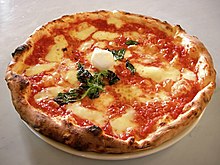
- Ai frutti di Mare – an Italian seafood pizza that may be served with scampi, mussels or squid[12]
- Calzone – folded over dough usually filled with ricotta and other ingredients
- Focaccia al rosmarino – a pizza based on rosemary and olive oil, sometimes served with prosciutto, usually served as appetizer
- Pizza ai funghi e salsiccia – pizza with mushroom and sausage or boscaiola, with mozzarella, mushrooms and sausages, with or without tomato
- Pizza al taglio – (Italian for pizza by the slice — literally "by the cut")[13] is a variety of pizza baked in large rectangular trays,[14] and generally sold in rectangular or square slices by weight, with prices marked per kilogram or per 100 grams.[15] This type of pizza was invented in Rome, Italy, and is common throughout Italy.[16]
- Pizza ai quattro formaggi – (four cheese pizza) with four different cheeses (sometimes melted together, sometimes in sectors), with (rossa, red) or without tomato sauce (bianca, white)
- Pizza alla napoletana (or Neapolitan) – tomato, mozzarella and anchovy
- Pizza capricciosa – with tomato, mozzarella, mushrooms, artichokes, black and green olives
- Pizza Margherita – tomato and mozzarella
- Pizza marinara – tomato, oregano and garlic
- Pizza pugliese – tomato, mozzarella and onions
- Pizza quattro stagioni – based on tomato and divided in four sectors, one for each season:
- Spring: cooked ham (prosciutto cotto) and black olives
- Summer: artichokes and anchovy
- Autumn: tomato and mozzarella (like pizza Margherita)
- Winter: mushrooms
- Pizza romana – tomato, mozzarella, capperi and anchovy
- Pizza siciliana – tomato, mozzarella, capperi, olive and anchovy
Pasta varieties (over 650)

- Agnolotti
- Bavette, bigoli, bucatini
- Cannelloni, crespelle
- Cappellini, cappelletti
- Conchiglie
- Ditalini
- Eliche
- Farfalle, festoni, fettuccine, filatieddi, fusilli
- Garganelli
- Gnocchi
- Gnocchi di semolino – dumplings made with semolina flour[17]
- Lasagna, linguine, lumache (snails), lasagnette
- Maccheroni (macaroni), malloreddus (Sardinian pasta), maltagliati, marille, marrubini
- Offelle, orecchiette
- Orzo
- Paccheri, paglia e fieno, pansotti, panzarotti, pappardelle, penne, perciatelli, pici, pinzillacchere, pizzoccheri,
- Ravioli, rigatoni
- Spaghetti, spaghetti alla chitarra, strozzapreti, strangozzi, strascinati
- Stelline – means "little stars" in Italian.[18] The pasta is shaped like small stars.[18]
- Testaroli – sometimes served with pesto[19]
- Tacconi, tagliatelle, tagliarini, tonnarelli, tortellini, trenette, trottole, trofie
- Vermicelli
- Ziti
Pasta dishes

- Bucatini all'Amatriciana, bucatini coi funghi, bucatini alla Sorrentina
- Cannelloni al ragù, cannelloni ai carciofi
- Carbonara
- Ciceri e Tria
- Fettucine Alfredo
- Lasagne
- Linguini with clam sauce
- Pansotti alla genovese – a type of huge ravioli
- Pasta al pesto
- Penne all'arrabbiata
- Ravioli, Klotznnudl
- Rigatoni con la Pajata, rigatoni al forno con salsa aurora
- Spaghetti alla Carrettiera, Spaghetti bolognese, spaghetti al nero di seppia, spaghetti alla Puttanesca, spaghetti con la bottarga, spaghetti all' aglio, olio e peperoncino, spaghetti indiavolati, spaghetti Siracusani, spaghetti alla carbonara
- Tagliatelle alla boscaiola, tagliatelle ai carciofi, tagliatelle ai funghi, tagliatelle al pomodoro, tagliatelle al sugo di lepre, tagliatelle al ragù
- Tortelloni alla zucca
- Tortellini, Cjarsons
- Tortelloni ricotta and spinach
- Trofie al pesto, trofie al sugo di noci
- Ziti
Riso (rice dishes)
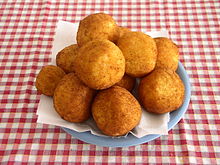
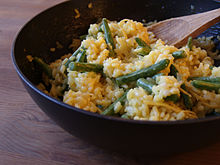
Rice (riso) dishes are very common in Northern Italy, especially in the Lombardia and Veneto regions, though rice dishes are found in all the country.
- Arancini
- Insalata di riso
- Pomodori col riso
- Risi e bisi – rice and peas
- Riso al nero di seppia
- Riso alla toscana
- Riso con i porcini
- Riso e indivia
- Riso tonnato
- Riso valdostano
- Risotto
- Risotto ai gamberoni
- Risotto ai quattro sapori
- Risotto al Barolo
- Risotto al cavolfiore
- Risotto al Gorgonzola – risotto prepared with Gorgonzola cheese[20]
- Risotto alla marinara
- Risotto alla milanese – risotto with saffron
- Risotto alla sbirraglia
- Risotto alla zucca
- Risotto allo zafferano con petto d'anatra
- Risotto con agoni
- Risotto con la lüganega
- Risotto con scamorza e champagne
- Risotto di seppie alla veneziana
- Risotto indivia e fiori di zucca
- Risotto saltato
- Sformato al basilico
- Sformato di riso dolce
- Tiella di riso, patate e cozze
Pesce (fish dishes)



- Acciughe fritte in pastella
- Acciughe in carpione
- Acqua pazza
- Acquadella o latterino fritto
- Agghiotta di pesce spada
- Alici, sardine, anguilla marinate
- Anguilla marinata – marinated eel[21]
- Baccalà
- Baccalà alla vicentina
- Baccalà fritto
- Boreto alla graisana
- Branzino al sale
- Brodetto di arselle
- Buridda
- Cacciucco
- Calamaretti fritti – fried squid[22]
- Calamari in zimino
- Calamari ripieni
- Capesante alla veneziana
- Cappon magro
- Carpaccio di pesce
- Cartoccio di pesce spada
- Cozze alla tarantina
- Cozze fritte alla viareggina
- Cozze ripiene
- Filetti di baccalà
- Filetti di orata al cartoccio
- Fritata di bianchetti
- Fritto misto di pesce
- Frittura mista di pesce
- Grancevola alla veneziana
- Impanata di pesce spada
- Involtini di pesce
- Missultin e polenta
- Moscardini lessati alla genovese
- Murena fritta
- Nasello al forno – baked hake
- Orata arrosto
- Orate al forno
- Pepata di cozze
- Pesce a scabecciu
- Pesce al cartoccio
- Pesce alla pizzaiola
- Pesce spada alla siciliana
- Pesce spada arrosto in salmoriglio
- Polpettine di mare
- Sarde a beccafico – stuffed sardines[23]
- Sarde arraganate (sarde con origano e pane)
- Sarde grigliate
- Sarde ripiene
- Sarde sfiziose panate
- Sardele in saor
- Sbroscia bolsenese
- Scampi a zuppetta
- Scampi gratinati
- Seppie col nero alla veneziana
- Seppie con i piselli
- Seppie ripiene
- Seppioline in umido
- Sogliole alla mugnaia
- Spiedini ai frutti di mare
- Spiedini di alici
- Spiedini di anguilla
- Stoccafisso alla genovese
- Stoccafisso alla ligure
- Tonno sott'olio
- Tortiera di cozze
- Totano imbottito
- Triglie alla livornese
- Zuppa di pesce
Carne (meat dishes and cured meats)


- Abbacchio alla Cacciatora
- Abbacchio brodettato
- Bistecca Fiorentina (steak Florentine)
- Braciole
- Bresaola
- Brodo
- Cacciatore – refers to a meal prepared "hunter-style" with onions, herbs, usually tomatoes, often bell peppers, and sometimes wine.
- Capicollo
- Carne al piatto
- Carne Pizzaiola – a dish derived from the Neapolitan tradition that features meat (often less expensive cuts of beef) cooked with peppers, tomatoes and olive oil
- Cevapcici
- Ciabusco
- Coda alla vaccinara
- Cotechino friulano or Musèt
- Cotechino Modena
- Cotoletta alla milanese
- Cotoletta alla petroniana
- Culatello
- Goulash or gulash
- Guanciale (cured pork jowl)
- Lonza
- Mortadella
- Oca (goose)
- Osso buco
- Pancetta (bacon)
- Pezzetti di cavallo
- Porcaloca
- Prosciutto affumicato (smoked ham)
- Prosciutto cotto (cooked ham)
- Prosciutto crudo
- Prosciutto di Parma
- Prosciutto di San Daniele
- Salame
- Salsiccia (sausages) including Salsiccia cruda
- Saltimbocca alla Romana
- Soppressata
- Speck Alto Adige PGI
- Speck friulano di Sauris
- Stigghiola
- Trippa alla Romana
- Violino Valtell
- Vitello (veal)
Verdura (vegetable dishes)

- Asparagi bianchi e verdi (asparagus)
- Caponata
- Carciofi alla Romana
- Crauti (sauerkraut)
- Panzanella – a Tuscan salad of bread and tomatoes, popular in the summer
- Peperonata
- Pestât
- Pinzimonio – Italian-style crudités[24]
Nut dishes
- Chestnut pie – has been documented back to the 15th century in Italy, in the book De honesta voluptate et valetudine ("On honourable pleasure and health") written by the Italian writer and gastronomist Bartolomeo Platina.[25]
Vino (wines)



- Abruzzi
- Calabria
- Cirò
- Emilia-Romagna
- Campania
- Friuli-Venezia Giulia
- Friulano
- Pignolo
- Ramandolo
- Refosco dal peduncolo rosso
- Ribolla Gialla
- Schiopettino
- Tazzelenghe
- Verduzzo friulano
- Liguria
- Lombardy (Lombardia)
- Oltrepò Pavese
- Barbera
- Bonarda
- Conero
- Franciacorta
- Sassella
- Grumello
- Inferno
- Marche
- Rosso Piceno Superiore
- Spumante Brut
- Valcalepio
- Verdicchio
- Piedmont (Piemonte)
- Apulia (Puglia)
- Sardinia (Sardegna)
- Sicily (Sicilia)
- Tuscany (Toscana)
- Umbria
- Veneto
Formaggio (cheeses)

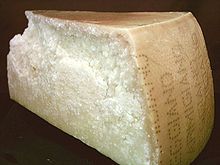
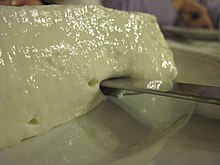
- Asiago
- Asino
- Bel Paese
- Bitto
- Bra
- Burrata
- Burrini
- Butirro
- Caciocavallo
- Cacioricotta
- Canestrato pugliese
- Caprino
- Casècc
- Casiello
- Castelmagno
- Casu modde
- Ciccillo
- Crescenza
- Crotonese
- Fiore Sardo
- Fontina
- Formadi frânt e Formadi salât
- Formai de Mut dell'Alta Valle Brembana
- Giuncata
- Gorgonzola
- Grana Padano
- Latteria
- Liptauer
- Malga
- Marzolino
- Marzotica
- Mascarpone
- Montasio
- Monte Re
- Monte Veronese
- Mozzarella
- Murazzano
- Parmigiano Reggiano (Parmesan)
- Pecorino di Fossa
- Pecorino friulano
- Pecorino romano
- Pecorino sardo
- Piacentinu
- Primo Sale
- Provolone
- Puzzone di Moena
- Quartirolo
- Ragusano
- Raschera
- Ricotta affumicata (Scuete fumade)
- Ricotta rifatta
- Ricotta salata
- Robiola
- Scamorza
- Slattato
- Squacquerone
- Stracchino
- Tabor
- Taleggio
- Toma
- Tumazzu
Desserts and pastry


- Aceto dolce – fruit preserves made with vinegar, honey, and grape juice[26]
- Anisette (cookie)
- Babà
- Biscotti
- Biscuit Tortoni
- Buccellato – a Sicilian circular cake given by godparents to the godchild and family on the christening day.
- Cannolo siciliano
- Cassata siciliana
- Chiacchiere – angel wings
- Ciarduna
- Crocetta of Caltanissetta
- Crostata
- Crostoli, Crostui
- Dobos of Trieste
- Frutti (fruits)
- Frutti di bosco (fruit with pastry)
- Gelato (ice cream)
- Gianduiotto and gianduia – hazelnut chocolates or spread
- Granita
- Gubana
- Macedonia – fruit salad
- Nocciolini di Canzo
- Pandoro
- Panettone
- Panforte
- Panna cotta
- Pastiera
- Piccoli Frutti – small garden fruits
- Pignolata
- Pizzelle
- Presnitz
- Profiterole
- Putizza and Pinza
- Semifreddo
- Sfogliatelle
- Tiramisù
- Torta Bertolina
- Torta caprese
- Strucchi or struki
- Strucoli or Strudel (Strudel)
- Struffoli – tiny fritters held together with honey and decorated with multi-colored sprinkles
- Zabaglione
- Zuppa Inglese
Caffè (coffee)
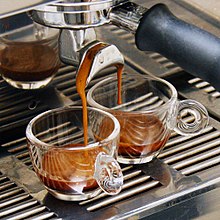
- Bicerin – coffee, hot chocolate and whipped cream, only in Turin
- Caffè corretto
- Caffè macchiato
- Caffelatte
- Cappuccino
- Espresso – known generally in Italy simply as caffè
- Granita
- Grolla dell'amicizia – coffee and grappa served in a traditional bulbous wooden loving cup, shaped like a multi-spouted teapot, and drunk in the Aosta Valley and Piedmont
- Marocchino – similar to a small cappuccino, invariably served in a glass, and drunk mainly in Turin, in the whole Piedmont and in Milan; similar to the espressino
- Ristretto
Famous dishes

- Baccalà alla Vicentina
- Bistecca alla fiorentina (Florentine beefsteak)
- Pollo alla cacciatora
- Salsiccia
- Lasagne
- Ossobuco
- Pasta e fagioli
- Pizza
- Ragù alla bolognese – a meat-based sauce served with tagliatelle or other pasta; the American dish Spaghetti alla Bolognese derives from this.
- Tortellini
Special occasions
- Stuffed Calamari in Tomato Sauce – Squid stuffed with breadcrumbs, garlic, oil/milk, and 3 eggs. The stuffed squid is baked with a white sauce, cheddar and olive oil.
- Deep Fried Fish/Shrimp – Fish/Shrimp dipped into batter and placed into deep fryer. Dish is typically served with lemon and/or cocktail sauce.
- Linguine with Clam Sauce – A mildly spicy dish that combines Linguine pasta served with tomato sauce and cooked clams.
- Marinated Eel – Bite-size cut eel deep fried and seasoned with salt and pepper marinated, after being fried, in a garlic, balsamic vinegar, and sugar sauce.
- Baccalà – De-salted, by soaking water, cod cut into bite-sized portions, pan fried until brown; and served with tomato sauce and pasta.
- Tiramisù – Layered dessert that incorporates layers of coffee soaked ladyfingers, marscapone crème with Marsala, and cocoa powder.
Unique dishes and foods by region
- Asino- cheese of Carnic Prealps
- Brovada or Brovade – cooked turnips that were preserved in marc it:Brovada
- Cjarsons – sort of tortellini with a ricotta filling, of the Carnic Alps
- Cuguluf – leavened cake of Viennese origin
- Formadi frânt" and Formadi salât – cheeses
- Frico – sliced cooked potatotes with onions and Montasio cheese
- Gubana – cake made with a very rich filling of dry fruits, raisins and candied citron
- Gulasch or Goulasch – alla triestina, alla goriziana, alla friulana
- Jota or Iota or Jote – soup made with beans, potatoes and sauerkraut
- Kaiserfleisch – smoked pork, sprinkled with grated horseradish and served with sauerkraut
- Kipfel – small fried crescent, made with a kind of potato dumpling dough
- Montasio – cheese of the Friuli
- Palatschinken – pancake filled with apricot jam or chocolate sauce
- Polenta – all over the region
- Porcina or Porzina – boiled pork served with mustard and horseradish
- Prosciutto di San Daniele DOP, famous ham exported all over the world
- Scuete fumade – sweet smoked ricotta
- Smoked hams of Sauris, of Cormons and of the Carso plateau
- Speck friulano of Sauris
- Bigoli con l'arna – a type of pasta similar to Tagliatelle but bigger with a sauce of liver of the duck
- Galani or Crostoli – pastries
- Lesso e pearà – boiled meats with pepper sauce, most common in the Province of Verona
- Pasta e fagioli – a soup of pasta and beans
- Polenta e osei – polenta accompanied with roasted wild birds
- Radicchio e pancetta – raw or cooked radicchio salad with pancetta
- Risi e bisi – rice with young peas
- Sarde in saor – fried, marinated sardines

- Canederli or Knödel – dumplings made with leftover bread and cold cuts
- Carnsalada e fasoi – aromatized salt beef with beans
- Crauti – Sauerkraut
- Minestrone di orzetto – barley soup
- Speck – juniper flavored ham
- Strangolapreti – spinach dumplings

- Mostarda di Cremona – a sweet/spicy sauce made with candied fruits and meant to be served along boiled beef.
- Nocciolini di Canzo – small sweet amaretto-style biscuits with hazelnut flour
- Panettone – a Milanese Christmas traditional sweet bread made with a yeast and egg dough along with candied citrus peel, and raisins
- Pizzoccheri – buckwheat tagliatelle dressed with potatoes, greens (often Swiss Chard or Spinach), butter and Bitto cheese: a speciality of the Valtellina.
- Risotto alla milanese – A stirred rice dish made with Vialone or Carnaroli rice flavored with saffron and beef marrow
- Torrone – a candy made of honey, sugar, and egg white, with toasted almonds or hazelnuts
- Tortelli di zucca – ravioli with a squash filling
- Tortino de riso alla valdostana – rice cake with ox tongue
- Zuppa di Valpelline – savoy cabbage stew thickened with stale bread
Piedmont (Piemonte)


- Bagna càuda – A hot dip based on anchovies, olive oil and garlic blanched in milk, to accompany vegetables (either raw or cooked), meat or fried polenta sticks
- Bollito misto
- Brasato al vino – stew made from wine marinated beef
- Carne cruda all'albese – steak tartare with truffles
- Gnocchi di semolino alla romana – semolina dumpling
- Lepre in Civet – jugged hare
- Paniscia di Novara – a dish based on rice with borlotti beans, salame sotto grasso and red wine
- Panissa di Vercelli" – a dish based on rice with borlotti beans, salame sotto grasso and red wine
- Panna cotta – sweetened cream set with gelatin
- Pere San Martin al vino rosso — winter pears in red wine
- Risotto alla piemontese – risotto cooked with meat broth and seasoned with nutmeg, parmesan and truffle
- Vitello tonnato – veal in tuna sauce
- Rane Fritte – fried frogs
- Riso e Rane – risotto with frogs
- Salame sotto Grasso – pork salami aged under a thick layer of lard

- Agliata – the direct ancestor of pesto, it is a spread made from garlic cloves, egg yolk and olive oil pestled in a mortar until creamy
- Baccalà fritto – morsels of salt cod dipped in flour batter and fried
- Bagnun (literally Big Bath or Big Dip) a soup made with fresh anchovies, onion, olive oil and tomato sauce where crusty bread is then dipped; originally prepared by fishermen on long fishing expeditions and eaten with hard tack instead of bread.
- Bianchetti – Whitebait of anchovies and sardines, usually boiled and eaten with lemon juice, salt and olive oil as an entrée
- Buridda – seafood stew
- Cappon Magro – a preparation of fish, shellfishes and vegetables layered in an aspic
- Cima alla genovese – this cold preparation features an outer layer of beef breast made into a pocket and stuffed with a mix of brain, lard, onion, carrot, peas, eggs and breadcrumbs, then sewn and boiled. It is then sliced and eaten as an entrée or a sandwich filler
- Cobeletti – sweet corn tarts
- Condigiun – a salad made with tomatoes, bell peppers, cucumber, black olives, basil, garlic, anchovies, hard boiled egg, oregano, tuna.
- Farinata di zucca – a preparation similar to chickpea farinata substituting pumpkin for the legumes' flour as its main ingredient, the end result is slightly sweeter and thicker than the original
- Galantina – similar to Testa in cassetta but with added veal.
- Latte dolce fritto – a thick milk based cream left to solidify, then cut in rectangular pieces which are breaded and fried.
- Maccheroni con la Trippa – A traditional savonese soup uniting maccheroni pasta, tripe, onion, carrot, sausage, "cardo" which is the Italian word for Swiss chard, parsley, and white wine in a base of capon broth, with olive oil to help make it satisyfing. Tomato may be added but that is not the traditional way to make it. (Traditional ingredients: brodo di gallina o cappone, carota, cipolla, prezzemolo, foglie di cardo, trippa di vitello, salsiccia di maiale, maccheroni al torchio, vino bianco, burro, olio d'oliva, formaggio grana, sale.)
- Mescciüa – a soup of chickpeas, beans and wheat grains, typical of eastern Liguria and likely of Arab origin
- Mosciamme – originally a cut of dolphin meat dried and then made tender again thanks to immersion in olive oil, for several decades tuna has replaced dolphin meat.
- Pandolce – sweet bread made with raisins, pine nuts and candied orange and cedar skins
- Panera genovese – a kind of semifreddo rich in cream and eggs flavoured with coffee, similar to a cappuccino in ice cream form
- Panissa and Farinata – chickpea-based polentas and pancakes respectively
- Pansoti – triangle-shaped stuffed pasta filled with a mix of borage (or spinach) and ricotta cheese, they can be eaten with butter, tomato sauce or a white sauce made with either walnuts or pine nuts (the latter two being the more traditional ligurian options)
- Pesto – Probably Liguria's most famous recipe, widely enjoyed beyond regional borders, is a green sauce made from basil leaves, sliced garlic, pine nuts, pecorino or parmigiano cheese (or a mix of both) and olive oil. Traditionally used as a pasta dressing (especially with gnocchi or trenette, it is finding wider uses as sandwich spread and finger-food filler)
- Pizza all'Andrea – focaccia-style pizza topped with tomato slices (not sauce) onions and anchovies
- Scabeggio – fried fish marinated in wine, garlic, lemon juice and sage, typical of Moneglia
- Sgabei – fritters made from bread dough (often incorporating some cornmeal in it)
- Stecchi alla genovese – wooden skewers alternating morsels of leftover chicken meats (crests, testicles, livers...) and mushrooms, dipped in white bechamel sauce, left to dry a bit and then breaded and fried
- Testa in cassetta – a salami made from all kind of leftover meats from pork butchering (especially from the head)
- Torta di riso – Unlike all other rice cakes this preparation is not sweet, but a savoury pie made with rice, caillé, parmigiano and eggs, it can be wrapped in a thin layer of dough or simply baked until firm
- Torta pasqualina – savory flan filled with a mixture of green vegetables, ricotta and parmigiano cheese, milk and marjoran; some eggs are then poured in the already-placed filling, so that their yolks will remain whole when cooked
- Trenette col pesto – Pasta with Pesto (Olive Oil, garlic, Basil, Parmigiano and Pecorino Sardo cheese) sauce




- Aceto Balsamico Tradizionale di Modena (Traditional Balsamic Vinegar) and Aceto Balsamico Tradizionale di Reggio Emilia (Balsamic vinegar) – very precious, expensive and rare sweet, dark, sweet and aromatic vinegar, made in small quantities according to elaborated and time consuming procedures (it takes at least 12 years to brew the youngest Aceto Balsamico) from local grapes must (look for the essential "Tradizionale" denomination on the label to avoid confusing it with the cheaper and completely different "Aceto Balsamico di Modena" vinegar, mass-produced from wine and other ingredients
- Borlengo from the hills South of Modena
- Cannelloni, Crespelle and Rosette – pasta filled with bechamel, cream, ham and others
- Capicola|Coppa – cured pork neck form Piacenza and Parma
- Cappellacci – large size filled egg pasta with chestnut puree and sweet Mostarda di Bologna, from Romagna.
- Cappelletti – small egg pasta "hats" filled with ricotta, parsley, Parmigiano Reggiano and nutmeg, sometimes also chicken breast or pork and lemon zest, from Emilia, in particular Reggio.
- Cappello da prete – "tricorno" hat shaped bag of pork rind with stuffing similar to zampone's, to be boiled (from Parma, Reggio Emilia and Modena)
- Ciccioli – cold meat made with pig's feet and head from Modena
- Coppa – cured pork neck form Piacenza and Parma
- Cotechino – big raw spiced pork sausage to be boiled, stuffing rich in pork rind (from Emilia provinces)
- Crescentine baked on Tigelle – (currently known also as Tigelle that is the traditional name of the stone dies which Crescentine were baked between) a small round (approx. 8 cm diameter, 1 cm or less thick) flat bread from the Modena Appennine mountains
- Crescentine – flat bread from Bologna and Modena: to be fried in pork fat or baked between hot dies (see Tigelle above)
- Culatello – a cured ham made with the most tender of the pork rump: the best is from the small Zibello area in Parma lowlands
- Erbazzone – spinach and cheese filled pie from Reggio Emilia
- Fave stufate – broad beans with mortadella
- Garganelli – typical Romagna quill shaped egg pasta usually dressed with Guanciale (cheek bacon), peas, Parmigiano Reggiano and a hint of cream.
- Gnocco Fritto – fried pastry puffs from Modena (Gnocco Fritto was a very local name: until few decades ago it was unknown even in neighbouring Emilian provinces where different denominations, i.e. Crescentine Fritte in Bologna, for similar fried puffs)
- Gramigna con salsiccia – typical Bologna short and small diameter curly pasta pipes with sausage ragù.
- Lasagne – green or yellow egg pasta layered with Bolognese Ragù (meat sauce) and bechamel
- Mortadella – baked sweet and aromatic pork sausage from Bologna
- Pan Pepato – very rich Christmas dried fruit and nut dessert with almonds, candies and a lot of sweet spices
- Parmigiano-Reggiano – prized ancient long-aged cheese from Reggio Emilia,Parma. Modena and Bologna
- Passatelli – noodles made of breadcrumbs, Parmigiano Reggiano, cheese, lemon zest and nutmeg from Romagna* Pesto di Modena – cured pork back fat pounded with garlic, rosemary and Parmigiano-Reggiano used to fill borlenghi and baked crescentine
- Piadina Fritta – Fried Romagna pastry rectangles
- Piadina – Pancake shaped flat bread (from Romagna) which can be smaller and higher or larger and very thin
- Pisarei e Fasò – pasta peas with beans from Piacenza
- Salame Felino – salami from Parma province
- Salamina da Sugo – soft sausage from Ferrara, seasonal.
- Spalla di San Secondo – gourmet salami from a small town near Parma; it is made with seasoned pork shoulder, stuffed in cow bladders and slowly boiled or steamed.
- Spongata – very rich Christmas time thin tart: a soft crust with flour sugar dusting, stuffed with finely broken almonds and other nuts, candies and a lot of sweet spices, from Reggio Emilia
- Squacquerone – sweet, runny, milky cheese from Romagna
- Tagliatelle all' uovo – egg pasta noodles, very popular across Emilia-Romagna; they are made in slightly different thickness, width and length according to local practise (in Bologna the authentic size of Tagliatelle alla Bolognese is officially registered at the local Chamber of Commerce)
- Torresani – roasted pigeons popular in Emilia
- Torta Barozzi o Torta Nera – barozzi tart or black tart (a dessert made with a coffee/cocoa and almond filling encased in a fine pastry dough (from Modena)
- Tortelli alla Lastra – griddle baked pasta rectangles filed with potato and pumpkin puree and sausage or bacon bits
- Tortelli – usually square, made in all Emilia-Romagna, filled with swiss chard or spinach, ricotta and Parmigiano Reggiano in Romagna or ricotta, parsley, Parmigiano Reggiano in Bologna (where they are called Tortelloni) and Emilia, or with potatoes and pancetta in the Apennine mountains
- Tortellini – small egg pasta navel shapes filled with lean pork, eggs, Parmigiano-Reggiano, Mortadella, Parma Ham and nutmeg (from Bologna and Modena: according to a legend, they were invented in Castelfranco Emilia by a peeping innkeeper after the navel of a beautiful guest)
- Zampone – stuffed pig's trotter, fat, but leaner than cotechino's, stuffing; to be boiled (from Modena)

- Bistecca alla fiorentina – grilled Florentine T-bone steak traditionally from the Chianina cattle breed.
- Crema paradiso – Tuscan cream
- Fegatelli di maiale – pig's liver forcemeat stuffed into pig's stomach and baked in a slow oven with stock and red wine
- Ossibuchi alla toscana – osso buco, sliced braised veal shank, "Tuscan-style"
- Pinzimonio – fresh seasonal raw or slightly blanched vegetables served with seasoned olive oil for dipping
- Ribollita – twice-cooked vegetable soup
Tuscan bread specialties
- Carsenta lunigianese – baked on a bed of chestnut leaves and served on Good Friday
- Ciaccia – from the Maremma made from maize
- Donzelle – round loaf fried in olive oil
- Fiandolone – made with sweet chestnut flour and strewn with rosemary leaves
- Filone – classic Tuscan unsalted bread
- Pan di granturco – made from maize flour
- Pan di ramerino – a rosemary bread seasoned with sugar and salt. The bread was originally served during Holy Week decorated with a cross on top and sold at the Church by semellai; it is, however, offered year round now.
- Pan maoko – equal parts wheat and maize flour, with pine nuts and raisins added
- Pane classico integrale – unsalted bread made with semolina with a crisp crust
- Pane con i grassetti – a bread from the Garfagnana area, with pork cracklings mixed in
- Pane con l'uva – in other areas this bread often takes the form of small loaves or rolls, but in Tuscany it is a rolled-out dough with red grapes incorporated into it and sprinkled with sugar. It is bread served often in the autumn in place of dessert and often served with figs
- Panigaccio – Lunigiana specialty made with flour, water and salt baked over red-hot coals and served with cheese and olive oil
- Panina gialla aretina – an Easter bread with a high fat content, containing raisins, saffron, and spices. It is consecrated in a church before being served with eggs
- Panini di San Antonio – sweet rolls eaten on the feast day of St. Anthony
- Schiacciata – dough rolled out onto baking sheet and can have pork cracklings, herbs, potatoes and/or tomatoes added to the top along with a salt and olive oil
- Schiacciatina – made with a fine flour, salt dough with yeast and olive oil
- Lenticchie di Castelluccio con salsicce – lentil stew with sausages
- Minestra di farro – spelt soup
- Piccioni all spiedo – spit-roasted pigeon
- Regina in porchetta – carp in fennel sauce
Specialties of the Norcineria (Umbrian Butcher)
- Barbozzo – cured, matured pig's cheek
- Budellacci – smoked, spiced pig intestines eaten raw, spit-roasted, or broiled
- Capocollo – Sausage highly seasoned with garlic and pepper
- Coppa – sausage made from the pig's head
- Mazzafegati – sweet or hot pig's liver sausage, the sweet version containing raisins, orange peel and sugar
- Prosciutto di Norcia – a pressed, cured ham made from the legs of pigs fed on a strict diet of acorns[27]
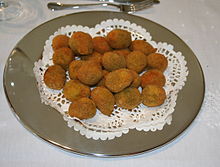
- Brodetto di San Benedetto del Tronto – fish stew, San Benedetto del Tronto-style, with green tomatoes and sweet green pepper.[28]
- Brodetto di Porto Recanati – fish stew, without tomato, wild saffron spiced.
- Olive all'ascolana – fried stoned olives stuffed with pork, beef, chicken, eggs and Parmesan cheese in Ascoli Piceno.[29]
- Passatelli all'urbinate – spinach and meat dumplings
Unique ham and sausage specialties
- Coppa – coppa in this region refers to a boiling sausage made from pig's head, bacon, orange peel, nutmeg and sometimes pinenuts or almonds. It is meant to be eaten within a month of preparation
- Ciauscolo – made from the belly and shoulder of pig with half its weight in pork fat and seasoned with salt, pepper, orange peel and fennel. It is stuffed into an intestine casing, dried in a smoking chamber and cured for three weeks.
- Fegatino – a liver sausage with pork belly and shoulder, where the liver replaces the fat of other sausages
- Mazzafegato di Fabriano – mortadella made from fat and lean pork with liver and lung added to the fine-grained emulsification. It is seasoned with salt and pepper, stuffed into casings and smoked. This sausage is often served at festivals.
- Prosciutto del Montefeltro – made from free-range black pigs, this is a smoked Prosciutto washed with vinegar and ground black pepper
- Salame del Montefeltro – made from the leg and loin meat of the black pig, this sausage is highly seasoned with peppercorns and hung to dry
- Salame di Fabriano – similar to salame lardellato except that it is made solely from leg of pork with pepper and salt
- Salame lardellato – made with lean pork shoulder, or leg meat, along with diced bacon, salt, pepper, and whole peppercorns. It is cased in hog's intestines, dried for one-and-a-half days and then placed in a warm room for 3–4 days, two days in a cold room and then two months in a ventilated storage room
- Soppressata di Fabriano – finely emulsified pork flavored with bacon, salt and pepper, the sausage is smoked and then aged

- Bucatini all'amatriciana – bucatini with guanciale, tomatoes and pecorino
- Carciofi alla giudia – artichokes fried in olive oil, typical of Roman Jewish cooking
- Carciofi alla romana – artichokes Roman-style; outer leaves removed, stuffed with mint, garlic, breadcrumbs and braised
- Coda di bue alla vaccinara – oxtail ragout
- Saltimbocca alla Romana – Veal cutlet, Roman-style; topped with raw ham and sage and simmered with white wine and butter
- Spaghetti alla carbonara – spaghetti with eggs, guanciale and pecorino
- Agnello casc' e ove – Lamb stuffed with grated pecorino cheese and eggs
- Agnello con le olive –
- Arrosticini – skewered pieces of meat
- Maccheroni alla chitarra – a narrow stripped pasta served with a sauce of tomatoes, bacon and Pecorino cheese
- Mozzarelline allo zafferano – mini mozzarella cheese coated with a batter flavored with saffron
- Spaghetti all' aglio, olio e peperoncino
- Sugo di castrato – mutton sauce made with onion, rosemary, bacon, white wine, and tomatoes


- Babà – Neapolitan rum-dippe dessert
- Braciole di maiale – Pork loin with tomatoes sauce, garlic, capers and pine nuts
- Caponata di pesce – Fish Caponata; bread (baked in the shape of a donut), anchovies, tuna, lemon juice, olive oil and pepper
- Casatiello – Neapolitan Easter pie with Parmesan cheese, Pecorino cheese, eggs, salame, bacon, and pepper
- Gattò – A Neapolitan potato casserole with ham, Parmesan cheese and Pecorino cheese.
- Graffe – fried Neapolitan "doughnuts" made with flour, potato, yeast and sugar.
- Insalata caprese – salad of tomatoes, Mozzarella di Bufala (buffalo mozzarella) and basil
- Limoncello – Lemon liqueur
- Maccheroni alla napoletana – macaroni with Neapolitan sauce; a sauce of braised beef, carrot, celery, onion, garlic, white wine, tomato paste and fresh basil.
- Melanzane a Scapece – Scapece eggplant; marinated eggplant with red pepper and olive oil
- Melanzane al cioccolato – mid-August dessert; eggplants with chocolate and almonds
- Mozzarella di Bufala Campana – Particular variety of cheese products made exclusively with milk from buffalo
- Mozzarella in carrozza – fried mozzarella with slices of toasted bread and olive oil
- Mustacciuoli – Neapolitan Christmas dessert; cookies with almonds and coffee covered with chocolate
- Parmigiana – Sliced eggplant pan fried in oil, layered with tomato sauce and cheese, and baked in an oven
- Pastiera napoletana – Neapolitan ricotta cake
- Pepata di cozze – Mussel and Clam soup with tomato sauce, served with slices of toasted bread.
- Pizza napoletana – neapolitan pizza; the most popular is "Pizza Margherita": pizza topped with tomatoes sauce, mozzarella cheese, Parmesan cheese, basil and olive oil
- Polipo alla Luciana – Luciana Octopus ; octopus with tomatoes sauce, chopped tomatoes, olives and garlic
- Ragù napoletano – Neapolitan ragù; tomatoes sauce, onions, olive oil, carrots, celery, veal shank, pork ribs, lard, basil, salt and pepper
- Roccocò – Neapolitan Christmas dessert; almond crunch cookies
- Sartù di riso – Rice Sartù; rice with mushrooms, onions, tomato-paste, beef, peas, Parmesan cheese and Mozzarella cheese and olive oil
- Sfogliatelle – Neapolitan ricotta dessert; seashell-shaped pastry with ricotta cheese.
- Sfogliatella Santarosa – Neapolitan dessert; Slightly larger than a traditional sfogliatella, it is filled with a crema pasticciera and garnished with crema di amarene (sour black cherry)
- Spaghetti alle vongole – Spaghetti with clams in a white sauce with garlic, olive oil and pepper
- Struffoli – Neapolitan Christmas dessert; honey balls with lemon juice and colored candy
- Torta caprese – Chocolate cake with almonds
- Zeppole di San Giuseppe – Fritters for Saint Joseph's Day; Cream-filled with crema pasticciera
Apulia (Puglia)

- Burrata – a fresh cheese with spun dough, similar to mozzarella but by much softer consistency and filamentous, produced in Murgia Andria in particular to its place of invention and in various areas of Apulia. The burrata is worked by hand with a filling of cream and pieces of dough spun, and the stuffing is called stracciatella, because the pieces of dough are torn by hand, and is contained in an envelope ("bag") is also formed by paste spun.
- Caciocavallo podolico – Is particoҪlar variety of cheese products made exclusively with milk from cows Podolica
- Cacioricotta – a cheese produced throughout the Apulia.
- Cartellate – a thin strip of puff pastry, made with flour, oil and white wine, together and wrapped on itself to form a sort of "pink" choreographed with cavities and openings, which is then fried in abundant oil. The typical recipe is one that sees impregnated "vincotto" lukewarm or honey.
- Muscisca – the bacon or boneless meat from sheep or goat (and in some cases young calf) is cut into long strips (20–30 cm) and thin (3–4 cm) and seasoned with salt, chilli and fennel seeds before to be put to dry in the sun, enough to get the drying
- Orecchiette alle cime di rapa – Ear-like pasta with rapini
- Ostriche arrosto – oysters broiled with parsley, garlic, oregano, breadcrumbs, olive oil and lemon juice
- Pancotto – is an ancient dish of Capitanata, poor but tasty, a basis of stale bread and a wide variety of wild vegetables, accompanied by fennel seeds, oil of Tavoliere and chilli peppers.
- Purea di fave – broad bean puree
- Riso, patate e cozze – this specialty of Bari based on rice can be compared to the paella, with traditional ingredients from area of Bari
- Tiella di verdure – casserole of baked vegetable topped with mozzarella cheese and fresh basil
- Torcinelli – involtini of offal linked with guts scented with parsley and cooked on the grill
- Zuppa di cozze alla Tarantina – mussels steamed with peperoncino, garlic, tomatoes, white wine and garlic
Apulian bread specialties
- Focaccia ripiena – bread dough filled with mozzarella, tomatoes, ham, onion or leek and served in slices
- Friselle – made from barley flour, duram wheat flour and go through a dual baking process, first in a hot oven and finished in a moderate oven
- Pane casereccio – made from duram wheat, yeast, flour, salt and water, this loaf is a tradition of the region
- Pane di Altamura – sourdough durum wheat bread weighing up to 44 lb (20 kg) in Apulia
- Puccia di pane – small, soft, round loaf made of white flour to remind the people of the Virgin Mary
- Puddica – bread dough mixed with mashed potato and rolled into flat cakes, covered with halved tomatoes and seasoned with salt and pepper
- Taralli – wheat flour, lard, olive oil, brewer's yeast, fennel seeds, red pepper and salt, baked into rings

- Agnello alla pastora – Lamb with potatoes.
- Baccalà alla lucana – Cod with crunchy red peppers.
- Ciaudedda – Stew with artichokes, potatoes, broad beans and pancetta
- Orecchiette con la salsiccia piccante – Ear-like pasta with typical spicy salami from Basilicata
- Pecorino di Forenza – Cheese made of sheep's milk, typical of the Forenza area.
- Pollo alla potentina – Potenza-style chicken; Chicken braised with tomatoes, onion, white wine, peperoncino, topped with fresh basil, parsley and pecorino cheese.
- Rafanata – Type of omelette with horseradish, potatoes and cheese.
- Cuzzupa
- Maccarruni i'casa home made pasta with goat or pork meat and tomatoea
- Melanzane alla menta – Eggplant marinated with mint
- Pesce spada alla ghiotta – swordfish rolls in tomato sauce
- Pipi chini padded pepper
- pisci stoccu Stockfish with olive, tomatoes and caper bush
- Pitta coi pomodori – pita bread with tomatoes
- satizzu typical sausages made with fennel and pepper
- Zippuli
Sicily (Sicilia)
- Caponata – eggplants with tomatoes and olives
- Il timballo del gattopardo – Sicilian pie; pastry dough baked with a filling of penne rigata, Parmesan, and bound a sauce of ham, chicken, liver, onion, carrot, truffles, diced hard-boiled egg and seasoned with clove, cinnamon, salt and pepper. Gattopardo (the Serval) makes reference to the arms of the Lampedusa family and Giuseppe Tomasi di Lampedusa’s well-known novel Il Gattopardo. (The dish does not contain catmeat.)
- Maccu di San Giuseppe – bean paste with fennel
- Panelle – a Sicilian chickpea fritter, often eaten as a sandwich and popular as street food
- Scaccia – flat bread stuffed in different ways
- Tonno alla palermitana – tuna Palermo-style; tuna marinated in white wine, lemon, garlic, rosemary and broiled, then served with pan-seared sardines
- Culurgiones – A kind of ravioli
- Malloreddus – semolina gnocchi with saffron
- Porcetto – Small pig cooked with myrtle
- Sa fregula – couscous
Ingredients
Most important ingredients (see also Italian Herbs and Spices):
- Olio extravergine di oliva (Extra virgin olive oil)
- Parmigiano Reggiano (aged cow's-milk cheese), in the North
- Pecorino (aged sheep's-milk cheese), in the Middle and South
- Pomodoro (Tomato)
-
Italian vine tomatoes
Other common ingredients:
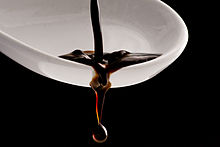


- Acciughe (anchovies, preserved in olive oil, or in salt)
- Aceto balsamico (Balsamic vinegar)
- Asparagi (asparagus)
- Baccalà (Dried, salted cod)
- Bresaola (air-dried salted beef)
- Broccoli
- Capperi (capers, preserved in vinegar or, more frequently, salt)
- Carciofi (artichokes)
- Cavolfiore (Cauliflower)
- Ceci (Chickpeas)
- Cetrioli (Cucumber)
- Cicoria (Chicory)
- Crauti (Sauerkraut)
- Fagioli (Beans)
- Farro (Emmer)
- Fragole (strawberries)
- Funghi (Porcini mushrooms, white mushrooms)
- Lardo (Lard)
- Lenticchie (Lentils)
- Limone (Lemon)
- Melanzane (eggplants)
- Mele (Apples)
- Miele (Honey)
- Nocce (Nuts)
- Olive (olives)
- Orzo
- Pasta
- Patate ( Potatoes)
- Pesce spada (Swordfish)
- Peperoni (Bell peppers)
- Pere (Pears)
- Pestât
- Pesto
- Piccoli frutti (Small Fruits)
- Pinoli (pine nuts)
- Piselli (Peas)
- Polenta
- Prosciutto
- Radicchio – a leaf chicory (Cichorium intybus, Asteraceae), sometimes known as Italian chicory. Radicchio rosso di Treviso resembles a large red Belgian endive.
- Ricotta
- Riso (Rice)
- Rucola (or Rocchetta) (Rocket or Arugula)
- Seppie (Cuttlefish)
- Speck
- Spinaci (Spinach)
- Tartufo (Truffle)
- Trippa (Tripe)
- Tonno (Tuna)
- Zucchine (Zucchini)
Herbs and spices
- Aglio (Garlic)
- Alloro (Bay leaves)
- Basilico (Basil)
- Cipolla (Onion)
- Finocchio (Fennel)
- Menta (Mint)
- Mentuccia (Calamintha nepeta)
- Origano (Oregano)
- Peperoncino (Chili pepper)
- Prezzemolo (Parsley)
- Rosmarino (Rosemary)
- Salvia (Sage)
- Timo (Thyme)
See also
References
- ^ "The Making of Italian Food...From the Beginning". Epicurean.com. Retrieved 24 April 2010.
- ^ Del Conte, 11–21.
- ^ Related Articles (2 January 2009). "Italian cuisine – Britannica Online Encyclopedia". Britannica.com. Retrieved 24 April 2010.
- ^ "Italian Food – Italy's Regional Dishes & Cuisine". Indigoguide.com. Retrieved 24 April 2010.
- ^ "Regional Italian Cuisine". Rusticocooking.com. Retrieved 24 April 2010.
- ^ "Cooking World » The most popular cuisines of the world (Part 1)". Cooking-advices.com. 25 June 2007. Retrieved 24 April 2010.
- ^ Freeman, Nancy (2 March 2007). "American Food, Cuisine". Sallybernstein.com. Retrieved 24 April 2010.
- ^ Franco-Iaquinto, A. (2014). Momma's Christmas Cookbook: Classic Italian Family Recipes to Inspire New Holiday Traditions. TriMark Press, Incorporated. p. 43. ISBN 978-0-9904211-0-8.
- ^ Hazan, Marcella (2011). Essentials of Classic Italian Cooking. Knopf Doubleday Publishing Group. ISBN 0307958302.
- ^ Scicolone, Michelle (2014). The Italian Vegetable Cookbook. Houghton Mifflin Harcourt. p. 67. ISBN 0547909160.
- ^ Johns, Pamela Sheldon (contributor) (2011). Cucina Povera: Tuscan Peasant Cooking. Andrews McMeel Publishing. p. 64. ISBN 1449408516.
{{cite book}}:|author=has generic name (help) - ^ Gutekanst, John (September 2014). "Fish Food: Seafood on pizza". Pizza Today. Retrieved 2 September 2014.
{{cite web}}: Italic or bold markup not allowed in:|publisher=(help) - ^ Garwood, Duncan; Hole, Abigail (2008). Lonely Planet Rome: City Guide. Lonely Planet. p. 185. ISBN 1741046599. Retrieved November 2012.
{{cite book}}: Check date values in:|accessdate=(help) - ^ Giudice, Teresa; MacLean, Heather (2011). Fabulicious! Teresa's Italian Family Cookbook. Running Press. p. 148. ISBN 0762442395. Retrieved November 2012.
{{cite book}}: Check date values in:|accessdate=(help) - ^ Buckley, Jonathan; Ellingham, Mark (2009). The Rough Guide to Tuscany & Umbria. Penguin. p. 36. ISBN 1405385294. Retrieved November 2012.
{{cite book}}: Check date values in:|accessdate=(help) - ^ Braimbridge; , Sophie; et al. (2003). A Little Taste Of...Italy. Murdoch Books. p. 16. ISBN 086411947X. Retrieved November 2012.
{{cite book}}: Check date values in:|accessdate=(help); Explicit use of et al. in:|last=(help)CS1 maint: multiple names: authors list (link) - ^ Chen, Patrizia (2010). Rosemary and Bitter Oranges: Growing Up in a Tuscan Kitchen. Simon and Schuster. pp. pt-50.
- ^ a b Knight, K.; Ruggiero, T. (2010). The Best Homemade Baby Food on the Planet. Fair Winds Press. p. 141. ISBN 978-1-59233-423-0. Retrieved 7 December 2015.
- ^ May, T. (2005). Italian Cuisine: The New Essential Reference to the Riches of the Italian Table. St. Martin's Press. p. 152. ISBN 978-0-312-30280-1.
- ^ Riso: Undiscovered Rice Dishes of Northern Italy. Open Road Media. 2012. pp. pt-63. ISBN 1453246274.
- ^ Cabrini, L.; Malerba, F. (2004). L'Italia delle conserve. Guide enogastronomia (in Italian). Touring. p. 58. ISBN 978-88-365-3293-3.
- ^ di Frischia, A. (2015). Ada Cooks Italy (in Italian). Lulu.com. p. 60. ISBN 978-1-326-19652-3. Retrieved 7 December 2015.
- ^ Tomarchio, R. (2014). Sicily Culinary Traditions:. Mnamon. p. 4. ISBN 978-88-98470-43-3. Retrieved 7 December 2015.
- ^ "Pinzimonio". Martha Stewart. 9 November 2015. Retrieved 7 December 2015.
- ^ Montanari, M.; Brombert, B.A. (2015). Medieval Tastes: Food, Cooking, and the Table. Arts and Traditions of the Table: Perspe. Columbia University Press. p. 115. ISBN 978-0-231-53908-1.
- ^ Laura Halpin Rinsky; Glenn Rinsky (2009). The Pastry Chef's Companion: A Comprehensive Resource Guide for the Baking and Pastry Professional. Chichester: John Wiley & Sons. p. 2. ISBN 0-470-00955-1. OCLC 173182689.
{{cite book}}: CS1 maint: multiple names: authors list (link) - ^ Piras, 256.
- ^ Bruni, Leonardo (2005). "IL BRODETTO MARCHIGIANO" (PDF) (in Italian). Retrieved 15 July 2012.
- ^ G.U.R.I. n. 46. "Iscrizione della denominazione "Oliva Ascolana del Piceno" nel registro delle denominazioni di origine protette" (in Italian). Retrieved 15 July 2012.
{{cite web}}: Unknown parameter|trans_title=ignored (|trans-title=suggested) (help)CS1 maint: numeric names: authors list (link)









